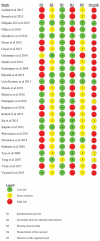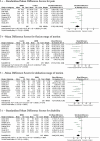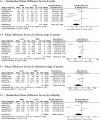Efficacy of mobilization with movement (MWM) for shoulder conditions: a systematic review and meta-analysis
- PMID: 34334099
- PMCID: PMC8865120
- DOI: 10.1080/10669817.2021.1955181
Efficacy of mobilization with movement (MWM) for shoulder conditions: a systematic review and meta-analysis
Abstract
Objective: To assess the effects of mobilization with movement (MWM) on pain, range of motion (ROM), and disability in the management of shoulder musculoskeletal disorders.
Methods: Six databases and Scopus, were searched for randomized control trials. The ROB 2.0 tool was used to determine risk-of-bias and GRADE used for quality of evidence. Meta-analyses were performed for the sub-category of frozen shoulder and shoulder pain with movement dysfunction to evaluate the effect of MWM in isolation or in addition to exercise therapy and/or electrotherapy when compared with other conservative interventions.
Results: Out of 25 studies, 21 were included in eight separate meta-analyses for pain, ROM, and disability in the two sub-categories. For frozen shoulder, the addition of MWM significantly improved pain (SMD -1.23, 95% CI -1.96, -0.51)), flexion ROM (MD -11.73, 95% CI -17.83, -5.64), abduction ROM (mean difference -13.14, 95% CI -19.42, -6.87), and disability (SMD -1.50, 95% CI (-2.30, -0.7). For shoulder pain with movement dysfunction, the addition of MWM significantly improved pain (SMD -1.07, 95% CI -1.87, -0.26), flexion ROM (mean difference -18.48, 95% CI- 32.43, -4.54), abduction ROM (MD -32.46, 95% CI - 69.76, 4.84), and disability (SMD -0.88, 95% CI -2.18, 0.43). The majority of studies were found to have a high risk of bias.
Discussion: MWM is associated with improved pain, mobility, and function in patients with a range of shoulder musculoskeletal disorders and the effects clinically meaningful. However, these findings need to be interpreted with caution due to the high levels of heterogeneity and risk of bias.
Level of evidence: Treatment, level 1a.
Keywords: Mulligan’s mobilization with movement; manual therapy; shoulder dysfunction; systematic review.
Conflict of interest statement
Kiran Satpute, Grant Mackay, Thomas Mitchell, and Toby Hall teach the Mulligan Concept on postgraduate physiotherapy courses, for which they receive a teaching fee.
Figures




References
-
- Luime JJ, Koes BW, Hendriksen IJM, et al. Prevalence and incidence of shoulder pain in the general population; a systematic review. Scand J Rheumatol. 2004;33(2):73–81. . - PubMed
-
- Littlewood C, Bateman M, Connor C, et al. Physiotherapists’ recommendations for examination and treatment of rotator cuff related shoulder pain: a consensus exercise. Physiother Pract Res. 2019;40(2):87–94. .
-
- NICE guidelines ‘Management of shoulder pain’ 2017. [accessed 2021 Mar 01]. Available from: https://cks.nice.org.uk/topics/shoulder-pain/management/initial-manageme....
-
- sitecore\lewis.ashman@rcseng.ac.uk. Subacromial Shoulder Pain - Commissioning Guide [Internet]. Royal College of Surgeons. [accessed 2021 Mar 01]. Available from : https://www.rcseng.ac.uk/library-and-publications/rcs-publications/docs/...
Publication types
MeSH terms
LinkOut - more resources
Full Text Sources
Medical
Research Materials
